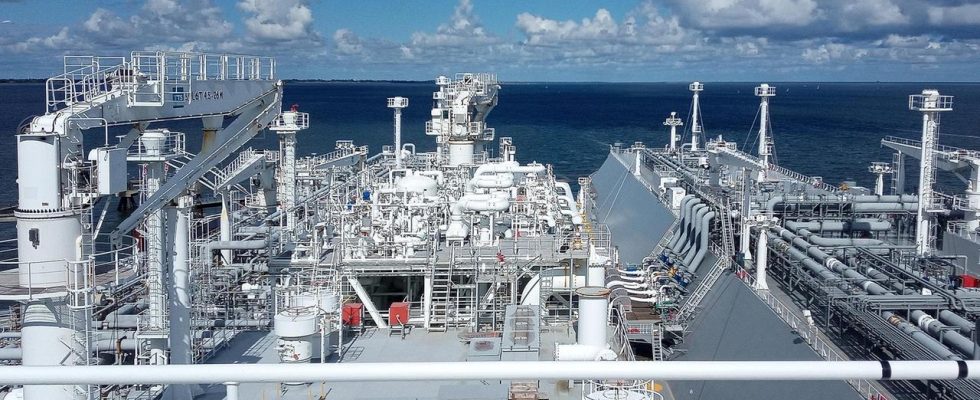To replace Russian gas imports, the federal government has invested billions in new LNG infrastructure. So far, however, the LNG share of imports has been quite low.
So far, only a small portion of German gas imports go through the billion-dollar LNG infrastructure for importing liquefied natural gas. This emerges from data from the Federal Network Agency. According to this, around 65.7 terawatt hours of LNG were imported since the opening of the first German LNG terminal in Wilhelmshaven a year ago until the beginning of December 2023. Overall, Germany’s gas imports totaled 933.4 terawatt hours during this time. The LNG share is then seven percent.
The federal government had promised LNG import capacities of 13.5 billion cubic meters of gas this year. This corresponds to more than 130 terawatt hours and therefore twice the amount of LNG that has actually been imported so far.
“Important building block for safe Power supply”
The traffic light coalition pushed forward the import because the liquefied natural gas was intended to make a significant contribution to securing Germany’s energy supply and preventing a gas shortage.
“Even if we do not yet have to fully utilize the capacities of the LNG terminals, the terminals are an important building block for an independent and secure energy supply in Germany,” said Kerstin Andreae, Chairwoman of the Executive Board of the Federal Association of Energy and Water Industries (BDEW). . “We can currently obtain cheaper pipeline gas. However, the situation on the energy markets is still tense. It is therefore important that we have the LNG terminals.”
The impending gas shortage last winter is still in sight, Andreae continued. The government has therefore done well to avoid such situations as a precaution.
Shortage situation currently unlikely
Gas storage operators currently believe that a gas shortage in Germany in winter is increasingly unlikely. This is the result of various scenarios presented by the Energy Saving Initiative (INES). Although gas shortage situations cannot be completely ruled out, their occurrence can be classified as less likely. The relatively mild temperatures in November also contributed to this, it is said.
A year ago there was still great concern in Germany that there could be bottlenecks following Russia’s delivery stop. In the event of a gas shortage, the energy-intensive industry would have had to expect shutdowns.
According to the operators, the gas storage facilities were 96 percent full at the beginning of December, an above-average value. INES managing director Sebastian Heinermann said: “Despite the recent cold temperatures and the resulting sharp increase in gas consumption, we will most likely get through this winter well.”
Wilhelmshaven is the most important terminal
The federal government has made around ten billion euros available for the provision of the LNG infrastructure. The LNG terminal in Wilhelmshaven, Lower Saxony, was the first in Germany to feed gas into the network on December 21, 2022. With a feed-in of 42.6 terawatt hours, it is also the most important German LNG terminal to date, according to data from Europe’s Gas Infrastructure Operators (GIE), to which the Federal Ministry of Economics also refers.
Brunsbüttel in Schleswig-Holstein has contributed 12.8 terawatt hours since the end of March. Since the end of April, there has also been a private terminal in Lubmin (Mecklenburg-Western Pomerania) with 6.7 terawatt hours.
Protests against reprimands
A fourth LNG terminal will be handed over to the state of Lower Saxony and the operator in Stade on Saturday. Two more floating terminals are to follow in Wilhelmshaven and Rügen in 2024. German Environmental Aid (DUH) recently lodged a formal objection to the planned LNG terminal on Rügen and called on the federal government to stop the project.
Stationary feeders are also planned in the future, also in order to be able to import hydrogen produced in the most climate-friendly way possible in the future. However, critics fear that the LNG infrastructure will create greater fossil energy capacity than is necessary to replace previous gas imports from Russia. New fossil infrastructure projects would block the urgently needed energy transition, argues the DUH.
USA is the most important LNG supplier
Germany imported the most gas this year with around 390 terawatt hours (TWh) from Norway, followed by the Netherlands (almost 232 TWh) and Belgium (almost 197 TWh). Because of the war in Ukraine, gas no longer flowed directly to Germany from Russia.
According to the non-governmental organization Global Witness, the amount of LNG imported from Russia by EU countries increased by 40 percent in the first seven months of the year compared to the same period in 2021, i.e. before Russia’s invasion of Ukraine.
Most LNG comes from the USA
According to the industry association BDEW, Germany sourced the vast majority of its LNG, 84 percent, from the USA. The gas is often obtained there using the controversial fracking method, which is considered to be harmful to the climate and the environment. Transport by ship and the prior cooling down to make the LNG transportable are also very energy-intensive. According to Statista, the United States is the world’s third largest exporter of LNG after Australia and Qatar.
According to BDEW, the origin of the individual tankers and the composition of the LNG transported cannot always be clearly determined.

